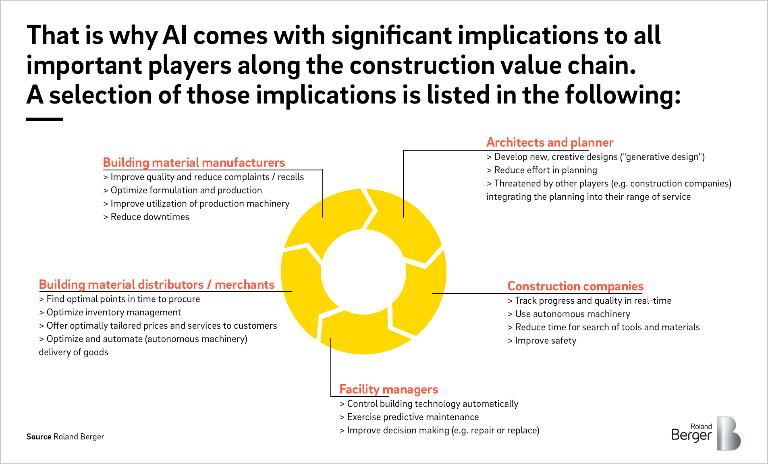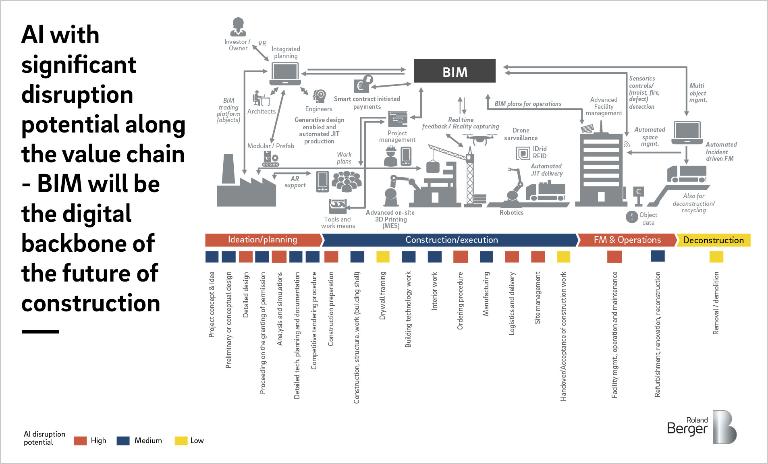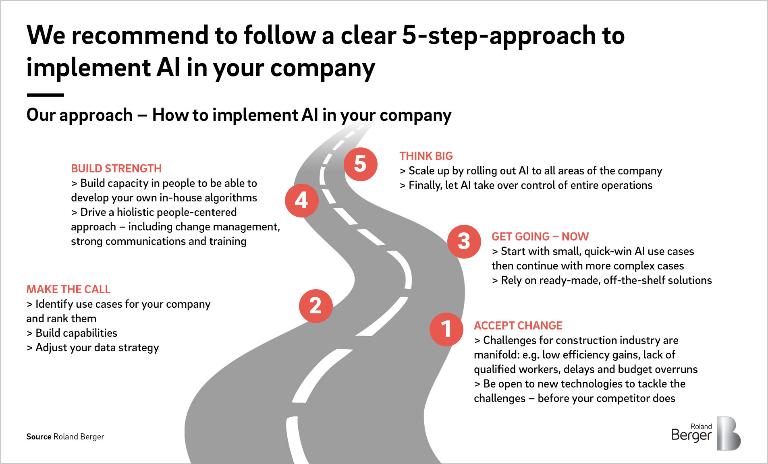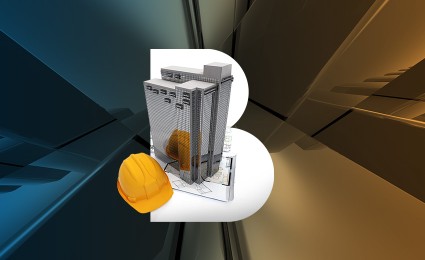

Artificial intelligence in the construction industry
How to increase efficiency over the entire lifecycle chain
The construction industries are on the verge of digitalization, which is disrupting traditional processes and also holds many opportunities in store. Artificial intelligence is expected to increase efficiency throughout the entire value chain – from the production of building materials to the design, planning and construction phase itself, and facility management as well. But how do you best benefit from AI in your company? Roland Berger recommends a five-step approach to introduce AI into your company.
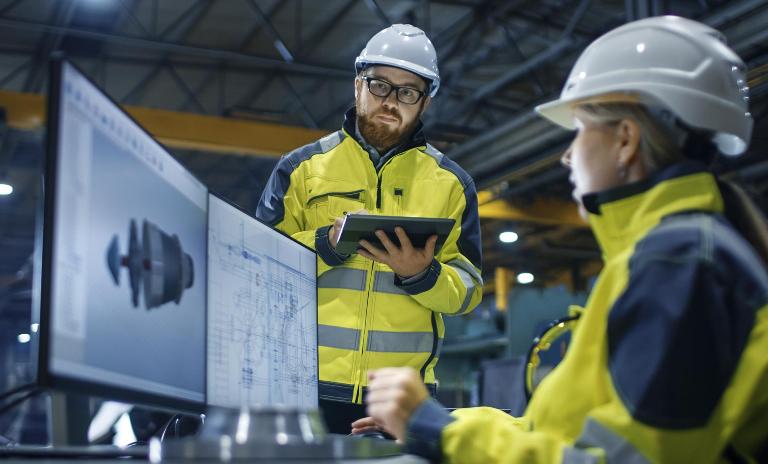
Use cases for AI in construction
Conceivable or real-life use cases for AI in different stages of the construction project lifecycle are manifold
Idea/design and planning
The ideation, design and planning processes are critical parts in a construction project's lifecycle. They need to run smoothly to finish any project on time, on quality and on budget.
Designers, engineers and architects regularly spend many hours working on designing the building. Especially time consuming is the process of creating design variations and checking the architectural statics and other parameters of the building (e.g. compliance with building regulations, does the building fulfill all functional requirements, and so on). Particularly in large construction projects such as infrastructure buildings, there are many examples of projects failing due to inaccurate planning.
This is where generative design, an AI based design exploration process, comes into play. An AI based system, with access to a database of many plans of buildings that have been built before, is able to develop design alternatives based on the knowledge it gains from the plans in the database. Designers and engineers can simply input design goals together with parameters such as spatial requirements, performance, materials, cost constraints and many more into the generative design software. Enabled by artificial intelligence, the software then explores all possible permutations of a solution, generating design alternatives that meet all previously specified requirements. The software then learns from each iteration what is a more suitable design choice so that it becomes a stronger tool with every new project.
This is a major improvement over the old-fashioned scripting as it allows for many more parameters and permutations to be considered. All the designer or engineer has to do is choose the most desirable design out of the alternatives available. As designing with generative design allows people to quickly generate the most efficient designs based on any parameters given, it enables the design and planning to be timelier, of higher quality and cheaper.
Beyond these improvements, generative design can even increase creativity. First, it allows possible ways of constructing shapes and curves to be found that architects could only dream of before. Second, generative design sometimes provides design solutions that designers and engineers would have otherwise never considered.
Within the AEC (architecture, engineering, construction) industry, designers and engineers are currently starting to adopt generative design. Recent studies and surveys indicate that around one third of architects and engineers are currently at least experimenting with generative design. Given the potential benefits, it can be expected that generative design will be further adopted by the AEC industry.
Delays in construction projects often stem from challenges and delays in the planning stage, which especially occur in major projects. One reason lies in the need to prevent clashes with utilities, which is relevant for the construction of urban infrastructure projects in particular.
Up until now, teams of engineers would compare planning documents with utilities around the construction site for weeks. Doing it this way necessitates numerous reworks and reassessments, consuming a lot of time and money.
AI can dramatically simplify this process. Artificial neural networks can carry out the detection of clashes in a day without the need for teams of engineers. This is helpful especially against the backdrop of a lack of planning and construction engineers in many countries. AI can not only detect potential clashes with utilities but can also find solutions for them and change the plans accordingly.
"Digital construction technologies will lead to new business models and go-to-market strategies across the entire industry."
Construction/execution
The productivity output of the whole construction industry has been improving marginally or not at all for several decades. One of the most important reasons lies within the construction site itself – its logistical inefficiencies.
First, at construction sites approximately one third of the time is spent on transports, rearrangements, downtimes and the search for materials. Second, construction projects often have to deal with challenges arising from delays in construction. Around 90% of megaprojects are significantly delayed, over budget or display other deviations from planning. All of these factors cause unnecessary costs for the companies involved in the construction process.
AI based solutions can help during the construction process in many ways. AI can improve construction execution planning, the updating of construction sequences and task management , while keeping all stakeholders always informed. Furthermore, AI can also increase the productivity within construction execution itself.
AI based tools could detect possible clashes, delays and changes within the construction process by comparing the digital twin of the building that is present in the Building Information Modeling (BIM) cloud against the actual physical representation. Robots and drones can already be used for frequent image recording and 360 degree laser scans. Those images and measurements provide the necessary input so that the AI can track the timely progress of the physical building against the plan stored in the BIM cloud. Furthermore, comparing the physical building progress against the digital twin enables automatic identification of errors/deviations from the original building plan during the construction phase. That provides the opportunity to react immediately, and thus perform troubleshooting at an early stage. This avoids the need for more costly correction at a later stage (e.g. if pipes or cables have been installed in the wrong location, they can be moved before all walls are closed). Possible delays and changes could potentially trigger the AI to perform an automatic change in the construction schedule that is stored in the BIM cloud. Building on this basis, all stakeholders, such as distributors and manufacturers, could be informed automatically. As a result, the construction site logistics would also be optimized as sub-contractors and suppliers could adjust their planning to the updated timelines. An AI driven construction process could therefore be the key enabler for just-in-time delivery of construction supplies.
A major driver of construction delays and cost overruns are accidents. Looking at figures from countries like Germany (6,000 accidents per year) or Japan (300 deaths and 15,000 injuries at construction sites every year), the importance of increased safety at construction sites is apparent. The use of AI in the form of computer vision in combination with cameras at the construction site might mitigate risks and reduce the number of accidents greatly. The potential for this can already be observed at some construction sites as a variety of companies have started offering image recognition software that can help construction workers find tools faster.
When a construction worker needs a certain tool, say a hot saw, they simply ask the AI by typing into their smartphone: "Where is a circular saw not in use?" The AI then scans the images from the many cameras on site and indicates the location of the closest hot saw. The construction worker then requests the AI to send authorized staff up to their location with the hot saw and the AI does so. In the process, AI improves both the utilization of tools and productivity, as construction workers do not have to walk around the construction site spending hours searching for tools and equipment. The advantage of AI over sensors/IoT is that it is much more flexible. Once the cameras are installed, every object can easily be found – whether or not it is IoT enabled. Real-life examples indicate the potential for a 40% increase in labor productivity combined with project completion at more than 10% below budget as the time of the construction workers and machinery can be used more efficiently.
Another advantage of the AI based solution over sensors/IoT is that it can also be taught to inform staff whenever it detects possible safety hazards (e.g. when a tool is not stored correctly or workers are not wearing safety gear). A responsible person would immediately be sent to that location to eliminate the safety hazard.
Beyond accident prevention, AI can also support operators of heavy and mobile machinery at the construction sites. Operators often perform several tasks simultaneously while working a machine. This leads to a high error rate and efficiency losses (e.g. an excavator losing material from its shovel before it can be put at the place it is meant to be). AI has the potential to simplify the use of heavy machinery drastically by assisting the machine operator in executing routine tasks. These repetitive pieces of work are tailor-made to be replaced by AI based tools, as they can learn and adapt these tasks easily. Then the operator can focus on more complicated and value adding tasks. The use of AI also increases safety in operating construction machinery. Cameras continuously observe the environment and check for potential collisions with people or objects and can warn the operator before accidents happen or stop the machine itself. AI therefore enables operators to work faster and more precisely for longer periods. A company specializing in the control and automation of machinery claims that the productivity of mobile machinery could be increased by up to 60% using AI.
Supply/facility management
Facility managers must constantly find answers to very different questions: replace or repair, challenge an invoice or not, take action or wait, order replacement parts right now or not. Facility managers have to dedicate a lot of time to making these decisions, which are based on huge amounts of data collected during the project's lifecycle. This is costly and prone to error.
The huge amount of data being collected over time makes it perfect for the use of AI. Some companies are already taking advantage of this. AI-supported software can analyze data to help facility managers take proactive action. For example, AI can detect parts of buildings that are currently not being used and automatically deactivate the heating, ventilation and air conditioning in these parts, drastically reducing energy consumption. Similarly, cleaning and unnecessary maintenance for unused parts of the building can be canceled.
In the parts of the building that are in use, true predictive maintenance reduces the total cost of ownership even further. AI solutions combined with IoT sensors can recommend the optimal time to act (e.g. to clean a filter) before a potential problem arises but no earlier than needed, in order to save money. It can also automatically order replacement parts (e.g. for the air conditioner) to make sure that these parts are available on time. These processes can potentially be fully automated over time as AI learns and adapts to what the facility manager does. The next time a component is about to break, the AI will not need to inform the facility manager to check what should be done but will immediately order a new component. The facility manager also learns from AI whether it is really better to repair or replace the air conditioner. Moreover, project planning capabilities are improved: AI learns from the data of earlier facility management projects to predict the timeframes for maintenance or renovation works. The facility manager is then able to improve capacity planning.
AI enables facility managers to reduce costs by ensuring more efficient facility management. Thanks to AI, work is only done when it is needed or if it is needed at all. It also improves quality and reduces downtimes as it recommends the best way to react to anomalies.
AI along the steps of the value chain for construction material manufacturers and distributors
Aside from the opportunities for the use of AI along a construction project's lifecycle, AI can also be an enabler for the next big step in the digitalization of construction material producers and/or distributors. It would increase efficiency along the value chain in functions such as procurement, marketing and sales, manufacturing, logistics, customer service and aftersales of building material producers, merchants as well as building companies.
In procurement, AI can help companies forecast prices for raw materials (sand, gravel, iron, etc.) and other input factors. In order to do so, AI will analyze data on both past price development and the development of other factors that influence the price of a raw material, or even identify such relationships autonomously. AI can then forecast the price and determine the optimal point in time to buy. This can be connected to data on inventory so that AI is able to include the stock of certain raw materials in its calculations and perform optimized inventory management. With AI, it is going to be possible to automate more and more additional steps of the purchase-to-pay process. As described above, AI can identify the need for a product and then order said product. It automatically chooses the best supplier based on previous data (quality, punctuality, price, etc.). Upon receiving an invoice, AI automatically checks that it is correct before it is settled or declined.
The building materials industry has practically exploited the full extent of its potential to improve the production process. With the situation as is, there are not many possibilities for any significant efficiency enhancements left. AI could be the lever to initiate the next big leap into better quality and more efficiency.
Companies have the opportunity to collect huge amounts of data generated during the building materials production process (e.g. temperature, pressure, quality). This may be data from lasers, ultrasound examinations, cameras, thermometers or other devices. Using artificial intelligence to analyze and derive actions from this data can improve the results as well as the efficiency of production.
One positive example of that can be found in the production of steel. A consortium of research institutes and steel manufacturers, and others, are attempting to improve the quality of steel with the support of artificial intelligence. Variations in quality are eliminated by AI as it identifies the best combination of all parameters and adjusts them accordingly, and in doing so, AI realizes the best quality of produced steel possible. Should AI detect lower quality in the steel produced, it either initiates a reworking process immediately or it redirects the batches of steel to customers according to their quality requirements. As such, AI also improves the use of production capacities and reduces production downtimes by detecting problems in production at a very early stage. Furthermore, AI has the potential to lower energy usage and therefore energy costs. If building materials producers are able to copy this successful usage of AI, they too can drastically increase their efficiency.
In marketing and sales, AI helps companies target advertising expenditure even further and make tailored recommendations for the customers. This includes personalized offers to customers with prices, delivery dates, quality and quantity tailored to their customer profiles. These profiles are created by AI after analyzing all touchpoints between the company and its customer to ascertain the interests and preferences of the customer. This information can also be used to identify potential for cross-selling to the respective customer or to turn potential customers into real customers.
AI also helps further optimize logistics with regard to routes. Artificial intelligence identifies the best means of transportation and also the best routes based on information on times and dates, addresses, traffic, costs, speed, etc. In addition, it improves its recommendations with every delivery executed. In the future, these routes will be used by autonomous transportation modes like cars, trucks, ships and planes.
In customer service and aftersales, AI supports and relieves the staff by answering customer inquiries automatically. Today, there are already chatbots operating in customer service that speak and answer like human beings, with the result that people often do not notice that they're talking to an AI instead of a human being. Not only does this save money, it also results in a higher quality of customer service as the staff can focus on more difficult inquiries as required.
AI already supports other overhead functions, too. Examples are the automated processing of mails (e.g. forwarding an incoming mail to the responsible person) or the scheduling of meetings. AI also improves the capabilities of a firm in finance, accounting and controlling, analyzing historic financial data to derive the "best" business decisions or to assess the credit risk of the company's customers.
To conclude, we predict that AI will trigger significant changes along the entire construction value chain and the disruption potential is highest in areas that are characterized by repetitive, known tasks with limited uncertainty. The infographic above shows where the disruption potential is highest.
However, even though many companies have already identified potential for the use of AI within their company, they are struggling to set up a concrete plan to exploit the potential.
How to implement AI
We recommend the Roland Berger 5-step approach as a means to get started with artificial intelligence in your company. This approach outlines a realistic way to fully exploit the new opportunities arising from the use of AI.
- You have to accept that change is needed and create a matching atmosphere company-wide among your employees. To be successful in creating such an atmosphere of change, you'll need a dedicated communication strategy encompassing all employees, from the construction workers to the office staff. This is important particularly because many people see AI more as a threat than an opportunity. They are afraid that they will be replaced by AI and lose their jobs. So you have to outline the advantages of AI to every single employee. You have to pay attention not only to the messages but also to the timing of when you communicate what to whom to prevent rumors from spreading.
Bear in mind that many of the challenges described above are longstanding but have not yet been resolved. This means that it is time to get off the beaten path and try something new. Your employees need to be open to change as well as open to totally new technologies and thus willing to make use of AI. What is important is that you start now – before your rivals do – and work with your employees to give yourself a competitive edge.
This step is the most important for any successful implementation of AI tools because if you cannot convince your employees that change is needed and that the use of AI improves their way of working, they will be reluctant to change and will not use any of the AI tools you provide. - After creating an atmosphere of change, identify use cases for AI within your company. Rank them according to the main criteria: core vs. non-core business, ease of implementation (does it easily fit to current business processes, is there any off-the-shelf solution available), and efficiency gains in the short and the long term. At the same time, build up basic capacities for the use of AI, like data science knowledge and implementation expertise. The third part of this step relates to your strategy: you have to develop an AI strategy that fits into your overall strategy. A data strategy has to be one part of it. If you do not have one, create one. If you have one, adjust it according to the data you need for the identified use cases, and start and accelerate the required data collection activities. Your data strategy has to be complemented by a comprehensive IT strategy. The IT strategy should enable you to use the full potential of AI, which will be possible only if the IT you run and the IT department itself have the capability to fully support the implementation of AI based tools and to support your employees in working with those tools.
During this stage, you define the guiding principles for the subsequent implementation of AI in your company. So it is very important that the defined strategies and the identified use cases are perfectly aligned so that all departments share the same objectives. - Now, get started: Implement small AI projects (e.g. in support functions) that fit into your overall AI strategy, as you do not want to create a future where you have many incompatible AI solutions within your company. You should build on the long list of potential use cases and the theoretical guiding principles you defined in the second step. By initiating projects that can be expected to bring quick gains, you will illustrate the advantages of AI to everyone within the company and therefore create positive momentum. To minimize implementation difficulties, start with off-the-shelf solutions. Before you choose an off-the-shelf solution for your first AI use case, select the supplier carefully. It can make sense to choose the same supplier for different applications to leverage the potential of different AI tools working together. Therefore, screen the market for suppliers of AI tools and rate them according to a list of relevant criteria (e.g. breadth of AI offerings, support in implementation, price) before you finally select your supplier.
- After successfully implementing small, standardized AI solutions, the time has come for more ambitious applications and a holistic, people-centered approach. To give yourself genuine competitive edge over your competitors, you have to get away from off-the-shelf solutions and develop in-house algorithms specific to your company. You have to coach your people so that they are able to develop and operate such a system. This requires not only training but also well-designed change management and strong communication.
No later than at this stage, and the earlier the better, you should build up a dedicated digital or AI hub. This will be a department within your company that has the one task of driving the change across the entire organization towards a digitalized future generally and the increasing use of AI specifically. Companies that establish such a hub with broad-ranging powers report that the pace of implementation accelerates massively as a result. Successful hub creation requires organizational changes in advance, as the hub needs to be positioned at the highest level of the organization and the employees in the hub have to dedicate all of their working time to the hub and its tasks. - Expand your AI activities across the entire company. In the previous four steps you will have built the basis for the more extensive use of AI so that you are able to implement AI in all areas of the company. In every new area where you want to implement AI, do it the same way as before (start small then scale up). Be ready to transfer more and more control of operations to AI as it develops its full potential whenever it is able to change the parameters autonomously. That way, you will be able to defend the competitive edge you created by starting AI implementation today and following the four steps previously described.

